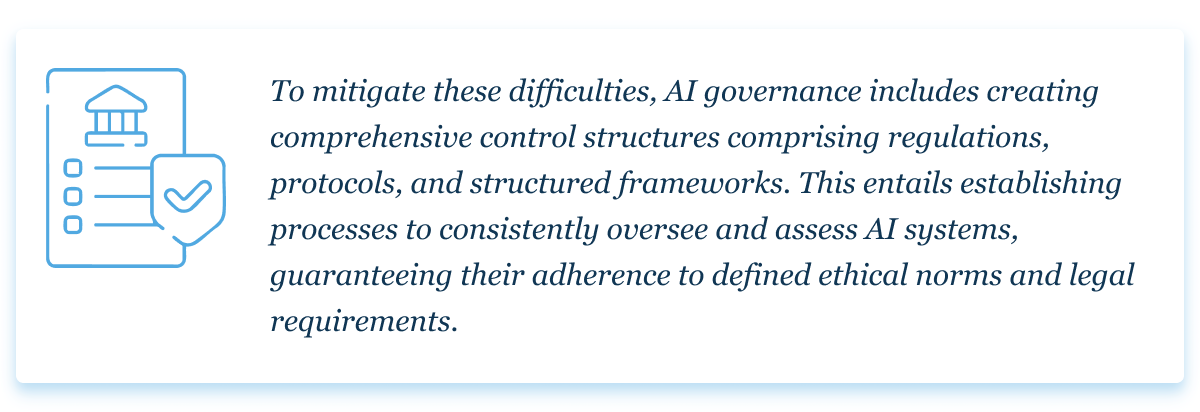Undoubtedly, artificial intelligence is a trend any company should have under its belt to stay at the top of the game. Unfortunately, like any other technological advancement, it also has some downsides, which is when artificial intelligence governance comes in handy.
AI accessibility has allowed millions of people to realize their dreams by streamlining information retrieval, content creation, and business intelligence. In this situation, any kind of data becomes a company’s most valuable resource—there can be no question of success without it. Properly applied AI governance tools help companies protect their data from being leaked or used in violation of human rights.
This article will answer all your questions connected with AI governance so you can comprehend why it is so important in modern business and what perspectives it can bring to your own.
What is AI governance?

This process involves tackling all regulatory measures to minimize risks such as improper use, biases, and privacy violations. As a result, it requires the engagement of various stakeholders, such as policymakers, users, AI developers, and others, to make the process ethically correct. This approach simplifies and guarantees that AI systems are created and employed in harmony with societal principles.
Though AI governance draws attention to some technical features of AI development, it is mostly concentrated on fixing bugs caused by human interference in AI formation. It’s pretty logical – as AI stems from extensively designed programming and machine learning models, all of which are human creations, it is susceptible to human glitches and biases. This concept is also relatable to generative AI development, as it is based on broad, open-source datasets for training.
To address certain challenges, artificial intelligence governance offers an organized framework for addressing each issue, ensuring that machine learning models and their training datasets are regularly supervised, assessed, and refined to avoid detrimental outcomes in AI-driven decisions.
Why is AI governance essential?

Effective AI governance is crucial for ensuring compliance, building trust, and achieving efficiency in the creation and use of AI technologies. As AI becomes increasingly embedded in both organizational and governmental processes, its potential to cause unintended harm has become more apparent.
Only a few months ago, the whole world was fascinated with the new Chinese startup DeepShark that could compete with the American ones. Now, it is facing a scandal that questions its compliance with privacy laws and data management practices. In January, the firm suffered a huge data leak, endangering more than one million sensitive records, including operational metadata, system details, API secrets, chat logs, and sensitive log streams.
Another famous example is COMPAS, a crime recidivism risk-assessment algorithm developed to appraise the possibility of a defendant’s recidivism, which turned out to be even less accurate than an untrained specialist.
These two cases perfectly show that even the most advanced technologies require sound governance in order to work properly and preserve societal confidence. Through the establishment of guidelines and frameworks, AI governance seeks to harmonize technological advancement with safety, ensuring that AI systems respect and uphold human dignity and rights.
Clear decision-making processes and the ability to explain them are essential for promoting the responsible use of AI systems and fostering trust. AI frequently makes decisions, such as selecting which advertisements to display or deciding on loan approvals. Comprehending these decision-making mechanisms is essential to ensure accountability and promote fairness and ethical standards in their outcomes.

Source: Unsplash
Besides assisting in achieving one-time compliance, AI governance platforms also bolster ethical standards in time. The changing AI strategy can lead to reliability and quality changes, which is why contemporary governance practices are evolving beyond basic legal compliance, emphasizing AI’s social responsibility. This approach helps protect against financial, legal, and reputational risks while fostering the ethical and sustainable advancement of technology.
Examples of AI governance in 2025
There are a lot of AI governance examples that include different frameworks, policies and practices that governments and companies use to promote the ethical and accountable application of their AI implementation strategy.

The GDPR serves as an example of AI governance, specifically resolving the problems of personal data privacy and protection. This regulation doesn’t focus only on AI, but a lot of its arrangements are suitable for AI systems, particularly those handling the personal data of individuals residing in the European Union.
The Organisation for Economic Co-operation and Development (OECD) was founded in 1961 to promote world trade and economic progress and now includes 38 member countries. Adopted in May 2019, their AI Principles encourage the adoption of AI that is both innovative and reliable while upholding human rights and supporting democratic principles. By complying with these rules, policymakers can handle the deployment of AI software development to augment outcomes and decrease risks.
Corporate AI ethics boards: Nowadays, the role of AI in the corporate world is considerable, which is why progressive companies create ethics boards or committees to manage AI initiatives, making sure they associate with modern societal values and ethical standards. For example, to report on innovative AI services and products and assist in aligning them with AI principles, IBM has developed an AI Ethics Council. Such boards typically comprise multidisciplinary teams with expertise in legal, technical, and policy domains.
Principles and standards of responsible AI governance
Artificial technology is developing at an extraordinary rate. This is especially noticeable with the appearance of generative AI, which has impressive potential for application across a wide range of fields because of its capability to generate new solutions and content.
However, this broad applicability can’t work in a decent way without powerful AI governance. It includes well-reasoned principles the organizations apply to the ethical utilization and development of AI applications.
It’s crucial to take seriously the choice of an AI governance partner. Otherwise, you can waste your money and time on a company that won’t bring you the expected results and put the security of your data at risk. The following principles can help you to spot the right one:
Bias control
Companies should conscientiously check out their training data to avoid incorporating real-world biases into machine learning algorithms. Eventually, it will establish unbiased and reasonable decisions.

Source: Unsplash
Transparency
Applying AI management is a very sophisticated process for any kind of business. That is why this process requires openness and clarity on how AI applications function and make decisions. In other words, companies must be prepared to describe the reasoning and logic behind AI-powered decisions.
Empathy
Despite the considerable progress that AI has made over the past two decades, it doesn’t have consciousness and is unable to have empathy. This implies that any organization that wants to leverage AI capacities must recognize its possible impacts on society – not only concentrating on technological and financial prospects.
For that reason, it is recommended to envision and count any probable societal repercussions of the technology and guide all stakeholders on the most effective strategies to minimize and manage these risks.

Source: Unsplash
Accountability
Robust AI governance obliges not only transparency and empathy but also a high standard of accountability to handle any possible changes that can introduce and uphold accountability for the technology’s consequences.
In 2023, the U.S. government introduced an executive order aimed at guaranteeing the safety and security of AI. This order outlined a thorough approach featuring frameworks designed to set new standards for handling the possible risks associated with AI technology. Among the key safety and security measures highlighted within the AI governance framework are:
-
AI safety and security
AI safety and security governance frameworks oblige developers of advanced AI systems to carry out safety evaluations and share essential data with the U.S. government. To make AI systems both secure and trustworthy, this also encompasses the advancement of standards, tools, and tests.

Source: Unsplash
-
Consumer, student, and patient data protection
These guidelines focus not only on fostering responsible AI governance practices within healthcare and education but also on maintaining the creation of life-saving medications and AI-driven educational tools.
-
Privacy and data protection
As highlighted in a recent Statista report, just 56% of consumers trust retailers to safeguard data when implementing generative AI tools. To address this, the U.S. government has introduced new directives focused on advancing privacy-preserving methods throughout both the research and development stages of AI technology. Additionally, the framework offers guidance for federal agencies to assess the efficiency of these privacy-enhancing techniques.

Source: Unsplash
-
Worker support
On the one hand, AI helps less experienced workers boost their creativity, on the other hand, it creates the risk of restricting job opportunities for people it may sooner or later replace. Worker support initiatives are designed to establish guidelines aimed at lessening the negative impacts of AI on employment and workplace conditions. Present efforts mainly concentrate on addressing job displacement and promoting workplace equality.
AI governance solutions
The importance of AI governance grows steadily as automation, fueled by artificial intelligence, becomes more widespread across diverse fields such as public services, finance, healthcare, and transportation.
Automated marketing analytics can considerably increase decision-making, efficiency, and innovation, while machine learning tools like natural language processing can take your application’s user experience to a new level. However, AI automation can cause difficulties with transparency, accountability, and ethical considerations.

To be effective, AI governance structures must be multidisciplinary, including professionals from different spheres, such as law, technology, business, and ethics. AI technologies are becoming an inseparable part of critical aspects of society, which is why the role of AI governance solutions in steering the course of AI advancement and its influence on society continues to grow in importance.
Effective AI governance practices extend beyond simple adherence to rules, embracing a more comprehensive strategy for supervising and overseeing AI applications. For large-scale enterprises, an AI governance framework should facilitate extensive monitoring and management of AI systems. Below is an illustrative roadmap to explore:
- Visual dashboard: A dashboard is an approach to demonstrating different types of visual data in one spot. Use dashboards that deliver live insights into the condition and performance of AI systems, enabling swift and comprehensive evaluations.
- Automated monitoring: Make sure that models operate accurately and uphold ethical standards by utilizing automated detection tools to identify bias, drift, performance issues, and anomalies.
- Health score metrics: Introduce a comprehensive health score for AI models to make monitoring more streamlined and accessible by applying clear and straightforward metrics.
- Custom metrics: Establish tailored metrics that match the company’s key performance indicators (KPIs) and benchmarks, ensuring that AI results effectively support business goals.
- Performance alerts: Arrange notifications to trigger when a model exceeds its established performance thresholds, allowing for swift corrective actions.
- Open source tools compatibility: Select open-source tools that integrate smoothly with numerous machine learning development platforms, suggesting versatility and the advantage of community-driven support.
- Audit trails: Ensure the availability of clear and accessible logs alongside audit trails to advance accountability and clarify the review process for AI systems’ actions and decisions.
- Seamless integration: To eliminate silos and foster streamlined workflows, make sure that The AI governance platform smoothly combines with current infrastructure, including software ecosystems and databases.
Following these methods, companies can arrange powerful AI governance platforms that promote the implementation, oversight, and ethical development of AI systems, guaranteeing their compliance with ethical principles and adjustment to business objectives.
What regulations require AI governance?
Some countries have already adopted AI regulations and AI governance practices to impede discrimination and bias. It should be mentioned that regulation is always in constant change, and organizations overseeing complex AI systems must remain vigilant as regional legal frameworks continue to evolve.
-
The United States SR-11-7
SR-11-7 serves as the United States regulatory standard for robust and effective model governance, specifically within the banking sector. The regulation mandates that bank executives implement organization-wide model risk management strategies and keep a catalog of models currently in use, under development, or recently retired.
Institution leaders are required to demonstrate that their models remain current, effectively fulfill their intended business objectives, and have not experienced drift. Additionally, model development and validation processes must ensure that anyone unfamiliar with a model can freely figure out its constraints, functionality, and primary assumptions.
-
Europe’s developing AI regulations
In April 2021, the European Commission introduced its AI package, which includes announcements about promoting a European strategy focused on trust, establishment, and excellence of a regulatory framework for artificial intelligence.
The statements divide AI systems into three categories: the ones that fall into the category of “minimal risk,” the ones that are pinpointed as “high risk” should obey more rigid rules, and the systems that are considered as “unacceptable risk” must be prohibited. Organizations should carefully follow these rules otherwise they will be fired.
-
The EU AI Act
The Artificial Intelligence Act of the European Union, entered into force on 1 August 2024, is considered the world’s first comprehensive legal framework for artificial intelligence. The UE AI Act fully prohibits certain AI applications while enforcing stringent requirements for risk management, governance, and transparency for others.

Source: Unsplash
General-purpose artificial intelligence models like Meta’s Llama 3 open-source foundation model and IBM Granite should also follow the rules of this act. Based on the nature of noncompliance, fines can vary from EUR 7.5 million or 1.5% of global annual revenue to EUR 35 million or 7% of global annual revenue.
The future of artificial intelligence governance
Gone are the days when AI technologies were considered a myth hidden in the walls of progressive labs. AI has already become part of our everyday lives, especially in business. It can change various business sectors for the better, but to make it possible, it requires good effort and care.
Artificial intelligence governance is a serious topic that needs both civic and governmental involvement. The partnership between civic organizations and government entities can be instrumental in defining the context-specific expectations for AI applications. This entails concentrating on key areas, including:
Safety considerations
Ensuring AI systems’ security and safety is much more complicated than it may seem at first sight. For example, when AI is utilized to tackle problems that are complex for humans to resolve, predicting every potential behavior of a system becomes exceptionally challenging. That is why organizations and governmental institutions should make joint efforts to avoid both deliberate and inadvertent misuse of AI.
Explainability standards
Although AI has become a part of our everyday lives, people are still afraid of this technological advancement and want to know how it works to trust and be confident.

Source: Unsplash
AI developers, especially in AI consulting, should always be ready to define why AI system works in a particular way. They also need to make sure there is accountability for the system’s actions and ways for people to challenge its results when needed. This can be achieved by arranging a set of best practices and offering guidelines for hypothetical scenarios, allowing industry leaders to analyze the benefits of AI use against real-world limitations.
Conclusion
Artificial intelligence for small businesses, healthcare, education, finance, and other sectors has already proved that this technology will stay for long, and it should be taken seriously in order to stay competitive. Sadly, with new benefits come new risks, but for many of them, there is one solution – AI governance. A good AI governance framework takes the best out of the technology and keeps the project efficient while protecting human rights and preventing bias and misuse.
It should be noted that this question is so serious that it needs the involvement of not only organizations but also governments. Only the combination of governmental and civic responsibility for the correct use of AI can help reap all the benefits and protect human rights at the same time.
FAQ
-
There are three basic pillars of AI governance – fairness and explainability, privacy and security, accountability, and ethics. They are used not only to build user confidence and protect confidential data but also to make sure that AI systems are accountable, transparent, and objective.
By establishing and comprehending these pillars, companies can make a positive impact on society, addressing AI technology challenges and protecting their users.
-
To provide effective management, deployment, and development, AI governance utilizes numerous technologies, such as risk management, regulatory frameworks, data governance, transparency mechanisms, ethical guidelines, public awareness and education, and so on.
-
The main goal of AI governance is to squeeze the maximum benefit while preserving the safety of human rights. It also helps to enhance public trust in AI systems by fostering transparency, promoting accountability, and encouraging fairness.
-
By guiding the usage, development, and research of AI, governance frameworks prioritize the protection of human rights, fairness, and safety. Robust AI governance comprises oversight systems that mitigate such risks as privacy violations, misuse, and bias while supporting innovation and enhancing trust.



